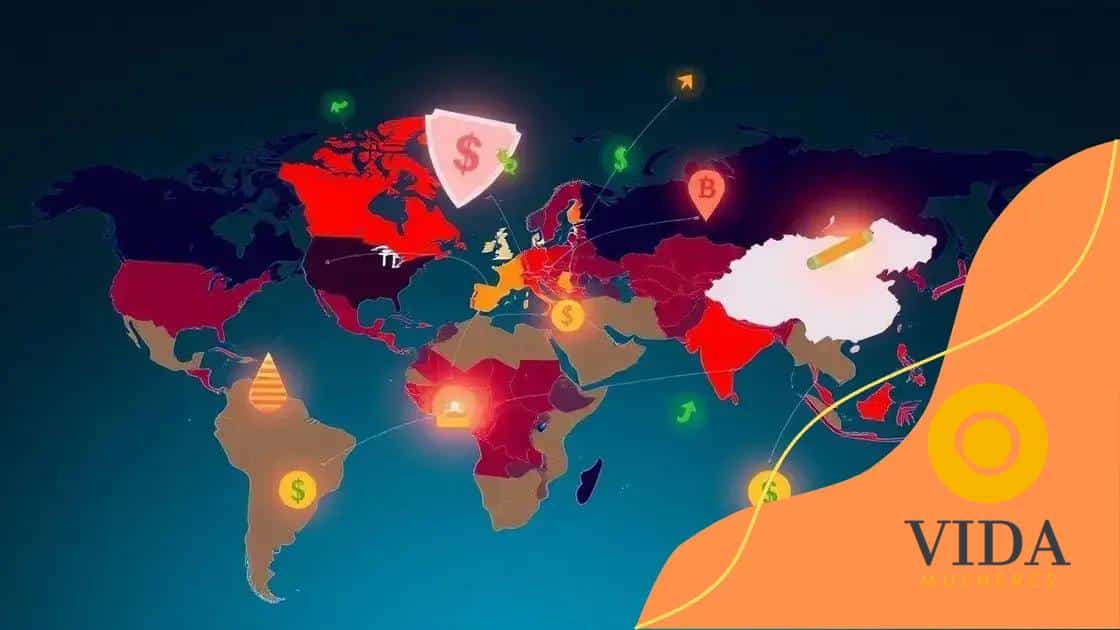Sovereign debt restructuring efforts intensify worldwide

Sovereign debt restructuring efforts intensify worldwide as countries adopt innovative strategies focusing on sustainable practices, technology, and international cooperation to address financial challenges and achieve stable recovery.
Sovereign debt restructuring efforts intensify worldwide, and this has become a critical focus for nations dealing with financial instability. Have you considered how such measures affect global economies and citizens alike? Let’s dive into the details.
Understanding sovereign debt restructuring
Understanding sovereign debt restructuring is crucial in today’s economic landscape. It involves countries renegotiating their debt obligations to alleviate financial pressures. This can help nations regain stability and promote recovery.
Sovereign debt restructuring can take various forms, such as extending payment deadlines, reducing interest rates, or even writing off portions of the debt. Each approach aims to create a sustainable path for nations to manage their economic challenges.
Key Concepts of Debt Restructuring
When discussing sovereign debt, it’s essential to understand several key concepts:
- Bondholder negotiations: This refers to the discussions held between the government and those who invested in government bonds.
- Debt relief: This often means reducing the total amount owed by the government.
- Economic reforms: These can be implemented in conjunction with restructuring to boost growth.
Through these negotiations, nations can navigate the complexities of their financial situations. It’s also important to consider how public opinion might influence these discussions. Citizens often desire quick solutions, making it vital for governments to balance long-term recovery with immediate needs.
Effects on Global Economics
The implications of sovereign debt restructuring extend beyond the borders of individual nations. When a country restructures its debt, it can impact global financial markets. Investors often watch these changes closely, as they can influence stock prices and international relations.
Additionally, if many countries undergo restructuring, it may signal broader economic instability. This can create a ripple effect, leading to increased scrutiny on governments’ financial health worldwide. Understanding these connections helps us grasp the bigger picture involved in managing sovereign debt.
Recent global trends in debt management

Recent global trends in debt management show that countries are adapting their strategies to cope with economic challenges. As the world faces uncertainties, nations are increasingly focused on innovative approaches to manage their sovereign debt effectively.
One of the most significant trends is the move towards sustainable debt practices. Countries are learning that managing debt is not just about repayment; it also involves ensuring that borrowing does not hinder future growth. This understanding is reshaping how governments think about their fiscal policies.
Key Strategies in Debt Management
There are several key strategies shaping recent trends in debt management:
- Debt issuance transparency: Nations are becoming more transparent in how they issue and manage debt, which builds trust with investors.
- Coordinated multilateral efforts: Countries are working together through global forums to find common solutions to debt crises.
- Focus on economic reforms: Governments are implementing reforms aimed at boosting economic growth alongside managing their debt levels.
In addition to these strategies, technology is playing a crucial role in modern debt management. Governments increasingly use data analytics to make informed decisions about borrowing and repayment. This shift allows for insights into economic conditions, helping nations avoid overextending themselves financially.
Another notable trend is the rise of public-private partnerships in financing infrastructure projects. By collaborating with private entities, governments can share the burden of debt while improving services and infrastructure. This trend not only helps manage debt but also stimulates economic growth.
Case studies: Successful restructuring examples
Case studies: Successful restructuring examples provide valuable insights into how countries have navigated debt crises effectively. Learning from these examples can aid other nations in similar situations.
One notable case is Argentina’s restructuring in 2005. After facing a financial meltdown in the early 2000s, Argentina worked with its creditors to renegotiate its debt, leading to a significant reduction in its overall debt burden. This restructuring not only eased immediate fiscal pressures but also set a precedent for how nations can approach their debt challenges.
Key Elements of Argentina’s Restructuring
Argentina’s approach included:
- Negotiation with bondholders: The government maintained open lines of communication with investors, fostering a collaborative atmosphere.
- Debt swaps: They offered new bonds at a lower value, which was attractive to creditors looking to recover some of their investments.
- Economic reforms: The country implemented policies aimed at stimulating growth, which played a crucial role in stabilizing its economy post-restructuring.
Another exemplary case is Ukraine, which underwent a significant restructuring in 2015. Faced with escalating debt and ongoing conflict, Ukraine negotiated successfully with international creditors. The government received substantial debt relief, allowing it to focus on its domestic reforms.
Highlights of Ukraine’s Strategy
Key strategies in Ukraine’s restructuring included:
- Engaging international partners: The collaboration with the International Monetary Fund (IMF) provided necessary support and credibility.
- Streamlined negotiations: Ukraine worked swiftly with its creditors to reach a consensus on debt reduction.
- Commitment to reforms: The government pledged to implement crucial economic reforms as a condition for the restructuring, fostering confidence among stakeholders.
Such successful examples showcase that effective communication, timely action, and commitment to reform are vital in the debt restructuring process. Other countries can learn that with the right strategies and collaboration, it’s possible to emerge stronger from economic challenges.
Challenges faced in debt negotiations
Challenges faced in debt negotiations can significantly impact the restructuring process. As countries seek to alleviate economic stress, numerous obstacles arise that can complicate agreements.
One major challenge is the variation in creditor demands. Different creditors may have conflicting interests and priorities, making it difficult to reach a consensus. For instance, commercial banks often prioritize immediate repayments, while multilateral organizations may be more flexible, focusing on long-term economic stability.
Key Issues in Negotiations
Some key issues that arise during debt negotiations include:
- Lack of transparency: When negotiations are not clear, it can lead to distrust among creditors and governments.
- Political pressures: Domestic political concerns can affect how leaders approach negotiations, often prioritizing short-term popularity over beneficial long-term solutions.
- Legal complications: Differences in legal frameworks between countries can complicate debt agreements and lead to lengthy disputes.
Additionally, understanding the economic conditions of a country plays an important role in negotiations. If a country is facing severe economic downturns, creditors may be reluctant to relax terms, fearing that they will not get repaid.
Communication is another critical factor in navigating these challenges. Without effective dialogue, misunderstandings can lead to prolonged negotiations. Successfully managing relationships with all stakeholders is essential to overcome these barriers.
Impact of Global Economic Conditions
Global conditions also affect debt negotiations. Economic crises can lead to sudden shifts in investor sentiment, affecting a country’s bargaining power. For example, if global interest rates rise, countries may find it tougher to negotiate favorable terms. Understanding these dynamics is vital for governments as they engage in debt discussions.
Future outlook for sovereign debt recovery
Future outlook for sovereign debt recovery is a critical topic as nations navigate the complexities of managing their financial obligations. As the global economy continues to evolve, various factors will shape the recovery landscape for countries burdened by debt.
One prominent trend is the increasing focus on sustainable development. Governments are recognizing that recovery strategies should align with long-term growth goals. This means prioritizing investments in education, infrastructure, and technology to boost economic performance while addressing debt levels.
Key Trends in Debt Recovery
Several key trends are emerging that will influence future debt recovery efforts:
- Multilateral cooperation: Countries are increasingly working together through international institutions like the IMF and World Bank. This collaboration can lead to better frameworks for addressing sovereign debt.
- Green financing: There is a growing push for financing that supports environmental sustainability. Nations that incorporate green initiatives into their recovery plans may attract more investment.
- Digital innovation: The use of technology in financial management is transforming how countries approach debt recovery. Tools like data analytics help governments make informed decisions.
Moreover, the impact of geopolitical dynamics cannot be overlooked. Political stability and international relations will play significant roles in shaping the willingness of creditors to negotiate favorable terms. Uncertain global conditions may create hesitance among investors.
As nations explore avenues for economic recovery, there is a clear recognition that addressing debt issues must go hand in hand with broader economic reforms. This interconnected approach not only stabilizes debt levels but also builds a resilience that can withstand future shocks.
FAQ – Frequently Asked Questions about Sovereign Debt Recovery
What are the main strategies for sovereign debt recovery?
Countries focus on sustainable development, international cooperation, and digital innovation to enhance debt recovery efforts.
How does digital innovation assist in debt management?
Digital tools improve data analysis and decision-making, helping governments manage debts more effectively.
Why is international cooperation important in debt negotiations?
Collaborating with international institutions improves outcomes and fosters trust among creditors and debtor countries.
What challenges do countries face during debt negotiations?
Challenges include varying creditor demands, political instability, and the need for clear communication.






